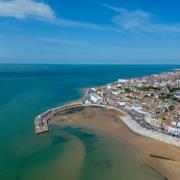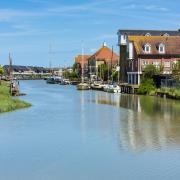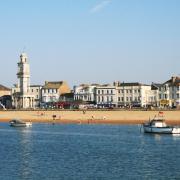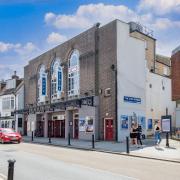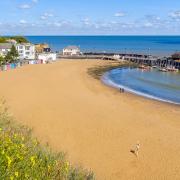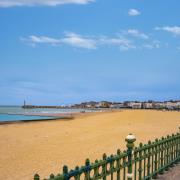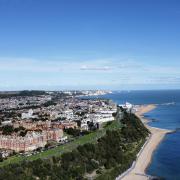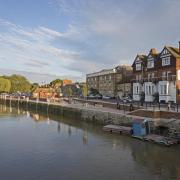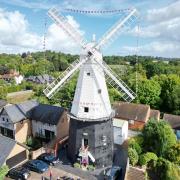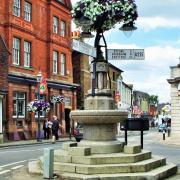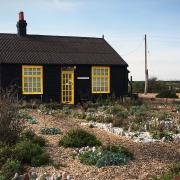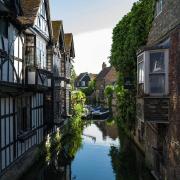One of the most stylish and attractive towns in the Weald, Tenterden is the balance of town and country, and a great place to find some truly original Christmas presents
Spotlight on Tenterden
One of the most stylish and attractive towns in the Weald, Tenterden is the balance of town and country, and a great place to find some truly original Christmas presents
Tenterden’s extraordinarily wide, tree-lined High Street welcomes you like a much-loved friend, and once you arrive, you’ll never want to leave. Because there’s so much pavement space you never feel pressured, so wandering amongst the interesting, upmarket shops is a pleasure, plus there’s a variety of lovely cafes, restaurants, tea shops and pubs to relax in.
Many of the predominantly independent traders are ‘feelgood’ retailers, specialising in interior design, fabrics, gifts, jewellery and antiques as well as high-class fashion. Everywhere you look there are sights to remember: grassland and trees kiss the pavement and white weather-boarded rows of buildings rub shoulders with red bricks and tiling. Stylishness abounds: even the lamp posts have flower-filled hanging baskets.
Around town
There are five convenient car parks plus street parking, and no appreciable hills. Start your tour in Sayers Lane, a wonderful assembly of modern, tasteful shops, many of whom have attractive bow-fronted windows and colourful blinds. With the Waitrose entrance behind you, go along Sayers Lane to the end, and turn left and go along the High Street: to the left is a three-storey 18th-century building called the Chandler’s Warehouse.
Like many of Tenterden's Georgian ‘brick’ buildings, the timber-and-infill frontage is actually concealed by ‘mathematical tiles’, ceramics designed to simulate brick. Soon you come to the Lemon Tree restaurant, whose black-and-white timbered premises, with alarmingly sloping floors, was originally a Wealden Hall House.
Next you come to the Caf� Rouge restaurant (once the old Eight Bells Inn), then Webbs’ huge store, comprised of three distinct sections, with a branch of Waterstones in between. Beside an interesting yellow building called the ‘Pebbles’ is the deceptively modern-looking, the White Lion Hotel, which is actually 400 years old.
After crossing Bridewell Lane and passing two churches, you find private houses with tremendously long front gardens. Just beyond here is Borough Place, a row of houses built on the site of the old workhouse, before you come to the war memorial. Pass the Methodist church and soon you’ll see a beautiful blue-painted Georgian house on the corner of Bennet Mews.
Cross the wide High Street here and you come to an area called Manor Row, a 1960s parade of shops built on the site of a medieval manor house. The area of tree-lined grass land beside the pavement here is called The Greens, the site of markets in the 1800s.
Turn right, and soon you come to another tranche of stylish shops and restaurants, many with bow-fronted windows, including Quill House with its incongruous rusty anchor outside. Look out for The Gateway, which incorporates the library and Tourist Information Centre.
Turn left at Station Road, and along here you’ll find the museum, a huge white weather-boarded structure next to a historic steam train. Returning to the High Street, turn left and you pass the attractive Vine Inn and more shops.
Cross Church Road and at this point, the High Street narrows considerably. Turn left down Church Road to see St Mildred’s Church. There’s a narrow path beside the churchyard, with shops to the right, and this leads back to the High Street, and the lovely white 1500s Woolpack Hotel. Next door is the grand Georgian Town Hall. After more shops, including W H Smith and a Country Outfitters shop, cross the High Street again, and go up beside Waitrose to reach your start point.
Major attractions
Tourist Information Centre, at Gateway (01580 762558). St Mildred’s Church, with its pinnacled 100ft tower, from where you can see as far as the coast. Tenterden and District museum (01580 764310). Romney Hythe and Dymchurch Railway (01797 362353) Britain's finest example of a rural light railway, which runs steam and heritage diesel trains (some over a century old) between Hythe and Dungeness via Dymchurch and New Romney. Model railway exhibition gift shops, caf�, etc. Colonel Stevens Railway Museum (0870 606074), at Tenterden Town station. See a range of personal mementos and 34 displays. Ellen Terry Museum, at Smallhythe Place (01580 762334), with a working theatre and cottage garden. Sinden Theatre (01580 763826), at Homewood School.
Shopping and Leisure
Tenterden Leisure Centre and recreation ground (01580 765987) has a large swimming pool, sports hall, tennis courts etc. Street market on Fridays outside the Town Hall in the High Street. Country Market on Friday mornings in St Mildred’s Church Hall, Church Road. Gibbet Oak Farm shop (01580 763938) – offering all kinds of fruit, jam, honey, bread and locally grown vegetables etc. Festive lights, entertainment, stalls and late-night shopping on the first Friday in December. Golf clubs: Biddenden par 3 Golf Course (01580 291215), Tenterden Golf Club (01580 763987) and London Beach Golf Course (01580 766279).
Nearby
Sissinghurst Castle Gardens (01580 710700). Woodchurch Village Life museum (01233 860240) – see the story of Woodchurch from the Stone age. Biddenden Vineyard and Cider Works (01233 291726) – the oldest in the country. Chapel Down Winery (01580 766111), England’s leading wine producer with herb garden and Vineyards restaurant. Rare Breeds Centre, Woodchurch (01233 861493), with animals, falconry and pig racing in 120 acres. C M Booth Collection of historic vehicles (01580 241234). St Michael and All Angels church in St Michaels, the neighbouring parish. Hole Park (01580 241344) with woodland gardens and a walled meadow. Woodchurch windmill (01233 860649).
PAST AND PRESENT
Once known as the ‘pig pasture of the men of Thanet’, or Tenet Waraden, (variously Tentevardene, or Tentyrden) the town grew to be a prosperous port, capitalising on adjacent Smallhythe’s access to the sea. Ship building was a major industry, so much so that in 1449 Henry V1 granted the town its Charter of Incorporation as a limb of the port of Rye – thereby a member of the prestigious Cinque Ports: in exchange for guaranteeing to supply ships and crew for the government, they received privileges including exemption from taxation and virtual self government. However in 1514 a disastrous fire destroyed Smallhythe and this, coupled with the increasing silting up of the River Rother, spelt death to the sea trading.
Pig farming was supplanted by sheep husbandry, establishing the wool trade, enhanced by the proximity of a port until 1331, when wool exporting was banned; but Flemish weavers and dyers taught their trade to the English, heralding a new boom time: the tower of St Mildred’s church was financed by wool trade barons in 1461. In the 1700s fruit and hop-farming flourished and Tenterden became an important market town. The settlement expanded throughout the 20th century – in 1899 the Pictorial Record described Tenterden as ‘one of the most interesting towns in Kent, with a reputation for being cheerful and lively’. The Rother Valley Railway was opened in 1900 – the first rural light railway in Britain, linking two main lines at Headcorn and Robertsbridge. Kent and East Sussex Railway was nationalized in 1948 but continued a passenger service until 1954, but the goods service closed 1961. It reopened as heritage steam railway and steam trains now run through the Rother Valley, manned by volunteers.
DID YOU KNOW
Mathematical tiles, ceramics made to mimic brickwork and used on many Tenterden buildings, were introduced as a ruse to avoid paying the brick tax Every October there’s a three-day folk festival, with Morris Dancing, Storytelling, street theatre, music and more In 1685 The Cinque Port barons disgraced themselves at James 11’s coronation when they were so drunk they dropped the ceremonial canopy they were carrying! The tower of St Mildred’s church has been used for centuries as a navigational aid for shipping, and a beacon light here warned of the Spanish armada. From here you can see as far as the channel
FAMOUS FOLK
William Caxton, the father of English printing, is thought to have been born in the town and a pub is named after him St Mildred, to whom Tenterden's church is dedicated, was the granddaughter of Egbert, founder of Thanet’s Minster Abbey Horatia, daughter of Lord Nelson and Lady Hamilton, was the wife of Tenterden’s vicar, Philip Ward Ellen Terry, the famous Victorian actress, lived in Smallhythe Place, her possessions establishing the Ellen Terry Museum there, the premises now owned by the National Trust Sir Donald Sinden lives nearby, and his favourite place in town is Webbs ironmongery store – in addition to being a world famous actor, Sir Donald is also a qualified and skilled joiner Jane Austen was a resident Samuel Tilden, governor of New York, who narrowly lost the 1876 US Presidential nomination was descended from the Tildens of Tenterden Benjamin Franklin visited the town in 1774 The Duchess of York (the Queen mother) visited three times and HRH Princess Diana, Princess of Wales, opened the Leisure Centre in 1990 Sir David Frost was born in the town
CONSIDERING A MOVE?
House values are on a par with those of outer London, with a one-bedroom flat costing around �157,000 and a two-bedroom one approximately �199,000. A two-bedroom house is likely to be in the region of �215,000, a three-bedroom semi �308,000 and a four-bedroom house will probably cost upwards of �500,000.
GETTING THERE
Tenterden is on the A28 between Hastings and Ashford, within an hour’s drive of the M25. The nearest mainline stations are Headcorn and Ashford International, that are linked to the town by bus. Buses link Tenterden to all towns in the locality. Call Traveline 0871 200 2233 for bus and train details. Satnav postcode for Tenterden High Street is TN30 6AU.
MY TOWN
Debbie Greaves, curator Tenterden Museum
What do you like about Tenterden museum?
The sense of a link between myself and the people who have lived in this area for the past thousand years. I find that as soon as I look into the history behind any of the exhibits they immediately become even more fascinating. I especially like our photographic archive, which has hundreds of photographs of people and local scenes going back to the 1830s.
What would you say to potential visitors?
As a fully registered museum, our standard of care of our collection is extremely high and we are very keen to promote our interest in local history.Our opening exhibition next year will be a display of Dinky toys from one of the largest collections in the UK, running for three weeks beginning the week before Easter.
Any hobbies relating to the town?
I have always enjoyed walking – it’s an excellent way to discover all the hidden parts of a district. I particularly like the areas around Tenterden which are still below sea level.
Do you have a favourite restaurant?
We have a great variety of restaurants, but I particularly like the Raja of Kent (01233 851191).
How would you improve the town?
De-clutter the High Street by removing a significant amount of meaningless roadside furniture.
What do you like about Tenterden?
It has a famous balance of town and country, plus a variety of shops and restaurants, an abundance of excellent schools, lovely footpath walks and a good climate for the vineyards.
What’s your oddest experience here?
I once shared a hot-air balloon ride with the parish vicar and as we paused over the rooftops of Tenterden he blessed the town and its people! I feel very lucky to live here.



